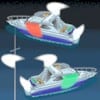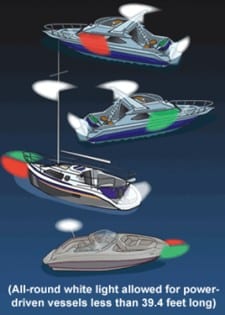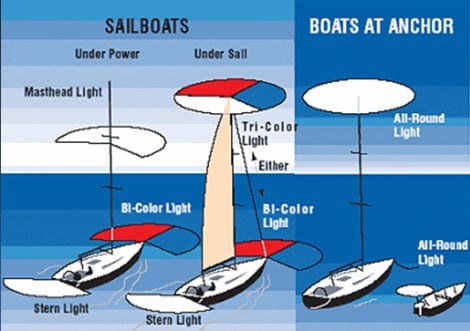 By Bob Currie, Vessel Examiner
By Bob Currie, Vessel Examiner
United States Coast Guard Auxiliary Flotilla 081-06-08
USCG Auxiliary Flotilla 081-06-08 is based at Coast Guard Station Galveston. The Auxiliary’s vessel examiners perform safety checks on all types of recreational boats. In this discussion of the Vessel Safety Check (VSC), we will discuss the requirements for navigation lights. Recreational vessels are required to display navigation lights between sunset and sunrise and other periods of reduced visibility (fog, rain, haze, etc.). Detailed lighting requirements for every description of watercraft are shown in the Navigation Rules. If you have downloaded the Coast Guard app to your smart phone, then you will find a copy of the Navigation Rules on that app. The information provided here is intended for power driven vessels and sailing vessels.
Basic Rules on Boating Navigation Lights

- Running lights (also called sidelights) are required on most all vessels, depending on length. Running lights are red for port and green for starboard, and shine from dead ahead of a vessel to 112.5 degrees aft, on either side. Depending on vessel configuration, the locations of running lights vary.
- Running lights also include the stern light (also called the anchor light), which is always white and, as the name implies, located on the stern. All-round stern lights shine through 360 degrees, and must be at least 3.3 feet above the red and green sidelights (now you know why that pole is so long).
- The running lights must have a separate switch from the stern light. If a vessel is not underway, the running lights should be extinguished and just the stern light should be illuminated. If your running lights are illuminated, this tells other craft that you are underway. Don’t forget to turn your running lights back on when you get underway.
- Powerboats under 65.5 feet are required to show running lights, a stern light, and a masthead light. Combination lights on the bow can be used.
- Vessels between 39.4 and 164 feet must show a white masthead light shining from 112.5 degrees on the port side through dead ahead and to 112.5 degrees on the starboard side. Boats in this category must also display a white stern light shining aft and 67.5 degrees to either side of dead astern.
- Power vessels less than 39.4 feet may show a single all-round light instead of separate masthead and stern lights.
- Sailboats under power are considered powerboats and running lights may be combined into a single bicolor combination light.
- Sailboats under 65.5 feet must show running and stern lights, which may be combined into a bicolor light and stern light, or a single tricolor light at the mast top.
The good news for recreational boat renters is that the Coast Guard has simplified navigation light regulations, which are now focused primarily on vessel length instead of vessel use. Further, the Coast Guard has developed standards for original navigation light equipment installed on boats. Thus, a boat renter can be assured that the location and configuration of navigation lights on a rental are legal for a vessel of its length and purpose. The most important takeaway from this discussion is to make sure your navigation lights work before you depart the dock or launch. You may not plan to be running at night, but you could have reduced visibility such that you would be required to use your navigation lights even during the daytime. Such events include rainstorms and fog.

This discussion today is just about the requirements for having navigation lights. In future columns we will discuss the actual use of navigation lights when meeting and passing other boats.
Question from a Boater
A boater who recently successfully underwent a Vessel Safety Check purchased a marine radio, which is a recommendation for any boater who plies the bounding main (or the Intracoastal Waterway for that matter). He wondered why there was a requirement to monitor the emergency channel (Ch. 16) even though there was no requirement to own a marine radio. My explanation was that marine radio ownership and use is a privilege granted by the government, and with that privilege there comes a requirement to monitor Ch. 16. Whenever the Coast Guard receives a distress signal, the Coast Guard will broadcast the specifics on Ch. 16 so that any boat in the vicinity may respond.
Additional Equipment Recommendation
If you have room aboard, consider carrying a Person in the Water (PIW) kit, which consists of one extra wearable PFD and a throwable Type IV PFD (cushion or ring float) with a line attached. This would mean you have one additional wearable PFD and two throwable cushions, one with a line attached.
For more information on boating safety, please visit the Official Website of the U.S. Coast Guard’s Boating Safety Division at www.uscgboating.org. Questions about the U.S. Coast Guard Auxiliary or our free Vessel Safety Check program may be directed to me at [email protected]. I am available to perform free Vessel Safety Checks, and I will come to your location to perform them. SAFE BOATING!
[10-16-2017]

 Posted in
Posted in 























